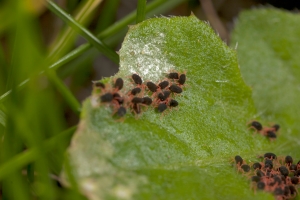Right conditions for rise in mites prompts call for best practice
Author: Toni Somes | Date: 27 May 2020

Southern New South Wales grain growers and advisers are being encouraged to have best practice management strategies in place for redlegged earth mite (RLEM) this season with numbers likely to increase in the cold and wet conditions.
Grains Research and Development Corporation (GRDC) Crop Protection Manager – North, Vicki Green, said with winter crop sowing underway and seasonal conditions right for RLEM (Halotydeus destructor) build up, it was critical growers and advisers had clear management strategies.
“Seasonal conditions are conducive to increases in RLEM populations and we are already hearing reports of growers with early infestations,” she said.
“RLEM feed on a range of plants including limited to canola, clover, faba beans and lupins and crops are most vulnerable during the establishment stage.
“The downside of this season getting off to a good start for growers, is conditions are also good for RLEM population build up.
“So growers who are now implementing control tactics need to be aware of best practice guidelines, because it is the only way we will prevent resistance and ensure we continue to have the chemistries available to control this pest.”
The call for a best practice approach comes in the wake of insecticide resistance being detected in RLEM populations in Victoria last month (April). While RLEM has had high levels of insecticide resistance in Western Australia for decades, this is the most eastern point resistance has been detected in Australia.
Since 2016, resistance to both synthetic pyrethroids, including bifenthrin and alpha-cypermethrin, and organophosphates, including omethoate and chlorpyrifos, has been detected in RLEM populations.
Entomologist Paul Umina from the scientific research organisation cesar, said the recent detection of resistance in Victoria was ‘low-level’ but served as a timely reminder for industry.
“If higher levels of insecticide resistance were to evolve to multiple chemistries and across larger areas, RLEM would be far more difficult to control on vulnerable establishing crops than what it is today in south-eastern Australia,” Dr Umina said.
Through a GRDC investment which supports scientific surveys and testing of suspect RLEM populations, cesar research scientist Aston Arthur collected RLEM populations in Victoria’s north in 2019, after an agronomist reported a spray failure with omethoate in 2018. The mites were collected from three paddocks in close proximity.
Back in the laboratory, Dr Arthur tested two organophosphate insecticides, omethoate and malathion, against these RLEM.
To determine if the test populations were expressing resistance, Dr Arthur ran a bioassay to compare their LC50 (the lethal concentration required to kill 50 per cent of the population) values to that of a known insecticide-susceptible population of RLEM.
Dr Arthur found at most a 7-fold increase when mites were tested against omethoate, and a 70-fold increase with malathion.
The test populations also underwent molecular testing to screen for resistance to synthetic pyrethroids.
No synthetic pyrethroid resistance was found in any of the test populations.
Dr Umina says the ubiquity of the RLEM across many broadacre crops and pastures means that it is frequently exposed to insecticides and faces a high selection pressure to evolve resistance.
For best practice help on minimising the incidence of RLEM as well as minimising the need for insecticide application go to GRDC’s Redlegged earth mite best management practice guide – Southern.
Another useful resource is the Resistance management strategy for the redlegged earth mite in Australian grains and pastures.
This strategy outlines various chemical control approaches based on scenarios where there is no resistance, resistance to synthetic pyrethroids only, resistance to organophosphates only, or resistance to both synthetic pyrethroids and organophosphates.
RLEM may be mistaken for other crop-feeding mites. For help with mite identification, see cesar’s PestBites episode on crop and pasture mite identification.
Listen to the GRDC podcast featuring Professor Ary Hoffman from the University of Melbourne discussing the evolution of pesticide resistance in RLEM.
-
GRDC PodcastPodcast
GRDC Podcast: Redlegged Earth Mite – a pesticide resistance evolution
A key research question that has an appreciable bearing on our future management of this pest relates to the way in which resistance has evolved in the Redlegged Earth Mite.
Date: 19 Feb 2020
Alongside cesar, project partners in this GRDC investment are CSIRO, the University of Melbourne, and the WA Department of Primary Industries and Regional Development.
Contact Details
For Interviews
Paul Umina, cesar
0405 464 259
Contact
Toni Somes, GRDC Communications Manager – North
0436 622 645
toni.somes@grdc.com.au
GRDC Project Code: UM00057,
Was this page helpful?
YOUR FEEDBACK


